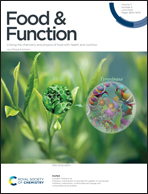Deciphering calcium-binding behaviors of casein phosphopeptides by experimental approaches and molecular simulation†
Abstract
Casein phosphopeptides (CPPs) as premium additives in functional foods can facilitate the transport and adsorption of calcium. The atomic resolution decipherment of calcium–CPP binding behaviors is critical for understanding the calcium bioavailability enhancement potential of CPPs. In the present study, the experimental methods (UV-vis, FTIR and isothermal titration calorimetry) and molecular dynamics simulation were combined to reveal the calcium-binding behaviors of β-casein phosphopeptides (1–25) (P5) with the best capability in carrying calcium ions. We found that it could carry approximately six calcium ions, and the calcium-binding sites were primarily located at the carbonyl group of Glu-2 and the phosphate group of phosphorylated Ser-15, Ser-18, and Ser-19. An interesting finding was that calcium ions could be bound by three coordinated modes, including unidentate, bidentate and tridentate geometries, resulting in the strong binding abilities. The binding process of calcium ions to P5 was spontaneous with the binding free energies of −5.2 kcal mol−1. Hydrophobic interactions were considered to be the major driving force for the calcium ion binding. The present study provides novel molecular insights into the binding process between Ca2+ and calcium-binding peptides.



 Please wait while we load your content...
Please wait while we load your content...